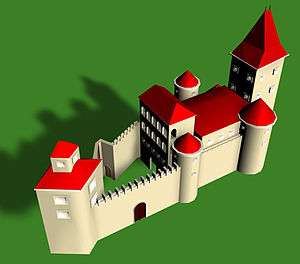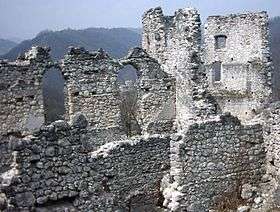Samobor Castle
| Samobor Castle | |
|---|---|
| Stari grad Samobor | |
| Samobor, Croatia | |
|
Ruins of the Samobor castle | |
 Samobor Castle | |
| Coordinates | 45° 80′ 0″ N, 15° 72′ 0″ E |
| Type | gothic castle |
| Code | HR |
| Site information | |
| Owner | Municipality of town Samobor |
| Open to the public | from 19th century |
| Condition | in ruins |
| Site history | |
| Built | between 1260 and 1264 |
| In use | 13th–18th century |
| Materials | stone |
| Demolished | 19th century |
Samobor Castle is now a ruin on the hill Tepec in the town of Samobor in Croatia. It lies only a 10-minute walk from the city centre, there are still visible remains of the moat, the massive entrance and most of the walls.
History
The first fort on this site, on a hill above the intersection of then important routes in the northwestern corner of the Sava valley above the medieval market town of Samobor, was erected by supporters of the Czech king Ottokar II of Bohemia between 1260 and 1264, who was than at war with Hungarian king Stephen V.[1] Croatian-Hungarian forces of knez of Okić near the Samobor soon retook the castle and knez of Okić was granted city of Samobor and also the privilege to collect taxes.
It was a stone fortress built on solid rock - in an irregular and indented layout, which consists three parts, of which the central core -is the oldest. In the southeastern part of the core is the high guard tower (today in ruins), the only remaining original part of Ottokar castle. With this tower lies a semicircular tower with a small gothic chapel of St. Ana from the third decade of 16th century.

In the third decade of the 16th century begins castle reshaping and gradually expanding core to the north - an elongated trapezoidal courtyard surrounded by a strong defensive wall with a pentagonal tower on the battery ends. Through the 17th and 18th century, the castle was upgraded and reconstructed,[2] as the last in the city was built three storey house with its southern side. In its upper part forms a courtyard whose facades with two sides articulated porches with Tuscan columns, and the interior is rich with equipment, so that the castle lost its fortification function and gradually turns into a countryside baroque styled castle. Last residents leave the castle at the end of the 18th century,[1] and then begins to decline from that stone building.
Rulers and owners

The first known rulers were feudal family Babonić,[1] then with Samobor Castle manages the Hungarian-Croatian kings, and in the 15th century became the property of the Counts of Celje. At the beginning of 15th century Castle comes into possession to feudal family Frankopan.[1] Then the castle changed many owners, Counts; Tržac, Tahy, Auersperg, Kiepach, the last owner of the castle who lived in it were Counts from house Erdödy-Kulmer. Municipality of town Samobor bought the castle in 1902. from last owner Montecuccoli and since then the castle and its surroundings serve as a town resort place.
Restoration
Today, the Samobor Castle is a picturesque ruin on the hill above the small creek Vugrinščak in Samobor. There is a project to renovate the Samobor Castle, but so far has been done just rehabilitation of the chapel walls, in restoration is used stone found in the ruined parts, cement and slaked lime.[3]
References
External links
- Samobor Castle on site Tourism ClusterSutla and Žumberak (Croatian)
- Samobor Castle, on Official Samobor site (Croatian)
- Tourist Board of Zagreb County, through County (Croatian)

